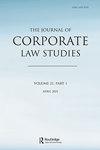Shareholder inspection rights: lessons from Australia
IF 1.5
4区 社会学
Q1 LAW
引用次数: 0
Abstract
ABSTRACT Information asymmetry between shareholders and corporate managers can subvert contemporary calls for increased institutional investor oversight. Information asymmetry can also arise between minority shareholders and controlling shareholders. This article examines the trajectory of shareholder inspection rights in Australia. It evaluates the effectiveness of an important shift in the 1980s from the narrow and prescriptive U.K. common law inspection right to a statutory regime, which confers broad discretion on the courts to decide whether inspection is appropriate. The article also explores the tension between inspection rights (which provide individual shareholders with access to non-public company information) and modern securities laws which promote market integrity by preventing selective disclosure of material information by listed entities. The Australian experience provides international law makers and researchers with important insights into the efficacy and implications of different models of regulating shareholder inspection rights.股东检查权:来自澳大利亚的经验教训
股东和公司管理者之间的信息不对称可能会颠覆当前要求加强机构投资者监督的呼声。小股东和控股股东之间也可能出现信息不对称。本文考察了澳大利亚股东检查权的发展轨迹。它评估了20世纪80年代英国从狭隘的、说明性的普通法检查权到法定制度的重要转变的有效性,后者赋予法院广泛的自由裁量权来决定检查是否适当。本文还探讨了检查权(为个人股东提供获取非上市公司信息的权利)与现代证券法(通过防止上市实体选择性披露重大信息来促进市场诚信)之间的紧张关系。澳大利亚的经验为国际法律制定者和研究人员提供了重要的见解,以了解不同的股东检查权监管模式的效力和影响。
本文章由计算机程序翻译,如有差异,请以英文原文为准。
求助全文
约1分钟内获得全文
求助全文

 求助内容:
求助内容: 应助结果提醒方式:
应助结果提醒方式:


